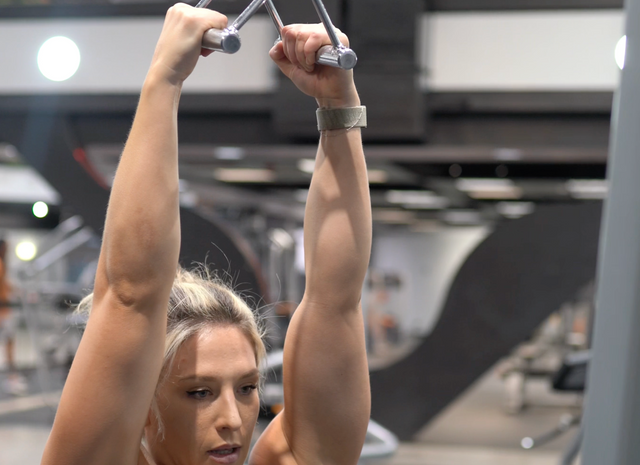Rear Delt Cable Fly: Build Shoulder Balance, Strength, and Definition
A strong, balanced upper body isn’t just about chest presses and rows. The rear deltoids, often neglected in training programs, are crucial for shoulder health, posture, and aesthetics. And when it comes to isolating and strengthening those rear delts with precision, few exercises are as effective—or as joint-friendly—as the rear delt cable fly.
In this article, we’ll break down exactly how to perform the rear delt cable fly, why it’s one of the most underrated cable movements, and how to integrate it into your shoulder or upper back routine for better results in strength, performance, and symmetry.
What Is the Rear Delt Cable Fly?
The rear delt cable fly is an isolation exercise that targets the posterior (rear) deltoid, which is the back portion of the shoulder. Performed on a cable crossover machine, it involves pulling the arms outward and slightly backward in a wide arc, using a lightweight load to create continuous resistance across the entire movement.
Unlike dumbbell reverse flys, the cable variation provides constant tension, allowing for more precise control and a longer time under tension—both of which are essential for muscle hypertrophy and joint-friendly training.
Benefits of Rear Delt Cable Fly
1. Improved Shoulder Symmetry
Most pressing exercises heavily target the anterior and medial delts. The rear delt fly balances out the shoulder by isolating the posterior deltoid, which helps improve overall shoulder proportion and aesthetics.
2. Better Posture
Weak or underdeveloped rear delts can lead to rounded shoulders and poor posture. Strengthening them helps pull the shoulders back into alignment and supports proper scapular positioning.
3. Injury Prevention
The rear delts contribute to shoulder stability, particularly in overhead movements. Strengthening them reduces risk of injury in pressing, pulling, and rotational exercises.
4. Enhanced Performance
Stronger rear delts support upper back and scapular movement, improving performance in rows, pull-ups, and Olympic lifts.
“Posterior deltoid and scapular stabilizer development is crucial for functional shoulder mechanics and injury prevention.” – Boettcher et al., Clinical Biomechanics
Muscles Worked in the Rear Delt Cable Fly
The rear delt cable fly is a targeted isolation exercise that primarily activates the posterior deltoid, but also involves a variety of supporting upper back muscles. This makes it a valuable accessory lift for improving shoulder strength, balance, and upper body stability.
Primary Muscle Worked:
-
Posterior Deltoid (Rear Delt)
The main muscle activated during the movement. The rear delt is responsible for shoulder extension, horizontal abduction, and external rotation—key actions in pulling and stabilizing the upper arm behind the body.
Secondary Muscles Worked:
-
Rhomboids
Located between the shoulder blades, the rhomboids assist in scapular retraction, helping you squeeze your shoulder blades together during the fly motion. -
Middle Trapezius
This portion of the traps stabilizes the scapula and works in tandem with the rhomboids to support proper shoulder blade movement. -
Teres Minor and Infraspinatus (Rotator Cuff Muscles)
These deep stabilizers help control external rotation of the shoulder and provide dynamic joint stability throughout the movement. -
Erector Spinae and Core Stabilizers
Engaged isometrically to maintain a neutral spine and stable torso position while performing the movement.
Why Muscle Isolation Matters:
By isolating the rear delts, this exercise helps correct muscular imbalances caused by overtraining the front delts and chest. It also enhances shoulder durability and pulling mechanics in compound lifts like pull-ups, rows, and overhead presses.
“Posterior deltoid and scapular stabilizer development plays a crucial role in injury prevention and maintaining balanced shoulder mechanics.” – Boettcher et al., Clinical Biomechanics
Common Mistakes to Avoid
-
Using Too Much Weight: This leads to momentum and traps taking over. Lighten the load and focus on strict form.
-
Pulling with the Arms or Traps: The movement should originate from the rear delts, not the arms or upper traps.
-
Not Controlling the Eccentric: Letting the weights snap back eliminates time under tension and reduces effectiveness.
-
Incorrect Arm Path: Avoid pulling straight back. Instead, sweep your arms outward in a reverse hug motion for optimal rear delt engagement.
-
Standing Too Upright: A slight forward lean (hinged at the hips) ensures better alignment and fiber recruitment.
Tips and Tricks for Better Results
-
Slow Down the Tempo: Use a 2–3 second eccentric to increase time under tension.
-
Squeeze at the Peak: Pause briefly when your arms are fully extended and your rear delts are contracted.
-
Train Rear Delts First (Sometimes): If they’re lagging, consider training them early in your session when you're fresh.
-
Use Cables Crossed or Uncrossed: Find what feels best for your body mechanics and range of motion.
-
Keep Wrists Neutral: Avoid excessive bending or rotating of the wrist during the pull.
Rear Delt Cable Fly Variations
1. Crossed-Arm Rear Delt Cable Fly
Grab the left cable with your right hand and the right cable with your left. This allows for a greater stretch and increased range of motion.
2. Uncrossed Rear Delt Cable Fly
Grab the right cable with your right hand and the left with your left. This offers a more direct line of pull for the rear delts.
3. Single-Arm Rear Delt Cable Fly
Perform the exercise one side at a time to correct imbalances and improve unilateral control.
4. Seated Rear Delt Cable Fly
Sit at a low pulley station or cable bench to reduce momentum and increase back isolation.
How to Do the Rear Delt Cable Fly (Step-by-Step)
-
Set Up: Adjust both pulleys to shoulder height. Stand centered between them.
-
Grip: Grab the left cable handle with your right hand and the right cable with your left (crossed arms).
-
Position: Step slightly forward and hinge at the hips, keeping a flat back and neutral spine.
-
Execution: With a slight bend in your elbows, pull the cables outward and slightly backward in a wide arc.
-
Squeeze: At the top of the motion, pause and squeeze the rear delts.
-
Return: Slowly return to the starting position under control, keeping tension throughout.
Perform 3–4 sets of 12–15 reps using a light to moderate weight with full range of motion.
Sample Rear Delt Cable Fly Workout (Shoulder/Upper Back Day)
-
Face Pulls – 3 sets x 15 reps
-
Rear Delt Cable Fly (Crossed) – 3 sets x 12–15 reps
-
Seated Rear Delt Dumbbell Fly – 3 sets x 12 reps
-
Wide-Grip Cable Row (Focus on Rear Delts) – 4 sets x 10 reps
-
Reverse Pec Deck or Single-Arm Rear Delt Cable Fly – 2 sets x 20 reps (finisher)
Conclusion: Why You Should Be Doing Rear Delt Cable Flys
The rear delt cable fly isn’t just a finishing move—it’s an essential exercise for anyone looking to build a strong, balanced, and injury-resistant upper body. With its ability to isolate the often-overlooked rear delts using controlled resistance and joint-friendly angles, this cable movement deserves a regular spot in your training split.
Whether your goal is posture correction, shoulder health, or symmetry-focused hypertrophy, mastering this movement will pay dividends. Stay focused on form, use lighter weights with strict control, and program it with intention—and your rear delts will catch up to the rest of your physique in no time.
Find similar articles:
Fitness






